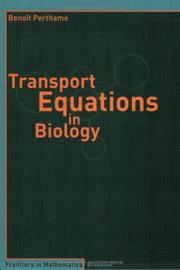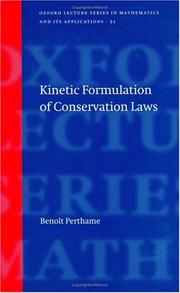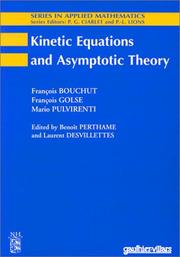| Listing 1 - 8 of 8 |
Sort by
|
Book
ISBN: 3319194992 331919500X Year: 2015 Publisher: Cham : Springer International Publishing : Imprint: Springer,
Abstract | Keywords | Export | Availability | Bookmark
 Loading...
Loading...Choose an application
- Reference Manager
- EndNote
- RefWorks (Direct export to RefWorks)
This book presents several fundamental questions in mathematical biology such as Turing instability, pattern formation, reaction-diffusion systems, invasion waves and Fokker-Planck equations. These are classical modeling tools for mathematical biology with applications to ecology and population dynamics, the neurosciences, enzymatic reactions, chemotaxis, invasion waves etc. The book presents these aspects from a mathematical perspective, with the aim of identifying those qualitative properties of the models that are relevant for biological applications. To do so, it uncovers the mechanisms at work behind Turing instability, pattern formation and invasion waves. This involves several mathematical tools, such as stability and instability analysis, blow-up in finite time, asymptotic methods and relative entropy properties. Given the content presented, the book is well suited as a textbook for master-level coursework.
Biology - General --- Biology --- Health & Biological Sciences --- Mathematics. --- Applied mathematics. --- Engineering mathematics. --- Biomathematics. --- Mathematical and Computational Biology. --- Applications of Mathematics. --- Math --- Science --- Differential equations, Parabolic. --- Computational biology. --- Mathematics --- Bioinformatics --- Parabolic differential equations --- Parabolic partial differential equations --- Differential equations, Partial --- Engineering --- Engineering analysis --- Mathematical analysis

ISBN: 3764378417 9783764378417 9786610727490 1280727497 3764378425 Year: 2007 Publisher: Basel : Birkhäuser,
Abstract | Keywords | Export | Availability | Bookmark
 Loading...
Loading...Choose an application
- Reference Manager
- EndNote
- RefWorks (Direct export to RefWorks)

ISBN: 0198509138 Year: 2002 Publisher: New York (N.Y.) : Oxford university press,
Abstract | Keywords | Export | Availability | Bookmark
 Loading...
Loading...Choose an application
- Reference Manager
- EndNote
- RefWorks (Direct export to RefWorks)
Conservation laws (Mathematics). --- Kinetic theory of gases.

ISBN: 9783764378424 9783764378417 Year: 2007 Publisher: Basel Birkhäuser Verlag
Abstract | Keywords | Export | Availability | Bookmark
 Loading...
Loading...Choose an application
- Reference Manager
- EndNote
- RefWorks (Direct export to RefWorks)

ISBN: 9783764378424 9783764378417 Year: 2007 Publisher: Basel Birkhäuser Verlag
Abstract | Keywords | Export | Availability | Bookmark
 Loading...
Loading...Choose an application
- Reference Manager
- EndNote
- RefWorks (Direct export to RefWorks)
These lecture notes are based on several courses and lectures given at di?erent places (University Pierre et Marie Curie, University of Bordeaux, CNRS research groups GRIP and CHANT, University of Roma I) for an audience of mathema- cians.ThemainmotivationisindeedthemathematicalstudyofPartialDi?erential Equationsthatarisefrombiologicalstudies.Among them, parabolicequations are the most popular and also the most numerous (one of the reasonsis that the small size,atthecelllevel,isfavorabletolargeviscosities).Manypapersandbookstreat this subject, from modeling or analysis points of view. This oriented the choice of subjects for these notes towards less classical models based on integral eq- tions (where PDEs arise in the asymptotic analysis), transport PDEs (therefore of hyperbolic type), kinetic equations and their parabolic limits. The?rstgoalofthesenotesistomention(anddescribeveryroughly)various ?elds of biology where PDEs are used; the book therefore contains many ex- ples without mathematical analysis. In some other cases complete mathematical proofs are detailed, but the choice has been a compromise between technicality and ease of interpretation of the mathematical result. It is usual in the ?eld to see mathematics as a blackboxwhere to enter speci?c models, often at the expense of simpli?cations. Here, the idea is di?erent; the mathematical proof should be close to the natural' structure of the model and re?ect somehow its meaning in terms of applications. Dealingwith?rstorderPDEs,onecouldthinkthatthesenotesarerelyingon the burden of using the method of characteristics and of de?ning weak solutions. We rather consider that, after the numerous advances during the 1980s, it is now clearthat solutionsinthesenseofdistributions'(becausetheyareuniqueinaclass exceeding the framework of the Cauchy-Lipschitz theory) is the correct concept.
Book

ISBN: 3030451976 3030451968 Year: 2020 Publisher: Cham : Springer International Publishing : Imprint: Springer,
Abstract | Keywords | Export | Availability | Bookmark
 Loading...
Loading...Choose an application
- Reference Manager
- EndNote
- RefWorks (Direct export to RefWorks)
This book presents the state of the art in mathematical research on modelling the mechanics of biological systems – a science at the intersection between biology, mechanics and mathematics known as mechanobiology. The book gathers comprehensive surveys of the most significant areas of mechanobiology: cell motility and locomotion by shape control (Antonio DeSimone); models of cell motion and tissue growth (Benoît Perthame); numerical simulation of cardiac electromechanics (Alfio Quarteroni); and power-stroke-driven muscle contraction (Lev Truskinovsky). Each section is self-contained in terms of the biomechanical background, and the content is accessible to all readers with a basic understanding of differential equations and numerical analysis. The book disentangles the phenomenological complexity of the biomechanical problems, while at the same time addressing the mathematical complexity with invaluable clarity. The book is intended for a wide audience, in particular graduate students and applied mathematicians interested in entering this fascinating field.
Biomathematics. --- Biology --- Mathematics --- Biomedical engineering. --- Biomechanics. --- Mathematical and Computational Biology. --- Biomedical Engineering and Bioengineering. --- Biological mechanics --- Mechanical properties of biological structures --- Biophysics --- Mechanics --- Contractility (Biology) --- Clinical engineering --- Medical engineering --- Bioengineering --- Engineering --- Medicine
Book

ISBN: 9783030451974 Year: 2020 Publisher: Cham Springer International Publishing :Imprint: Springer
Abstract | Keywords | Export | Availability | Bookmark
 Loading...
Loading...Choose an application
- Reference Manager
- EndNote
- RefWorks (Direct export to RefWorks)
Biomathematics. Biometry. Biostatistics --- General biophysics --- Human biochemistry --- medische biochemie --- biomathematica --- biomechanica


ISBN: 2842991109 Year: 2000
Abstract | Keywords | Export | Availability | Bookmark
 Loading...
Loading...Choose an application
- Reference Manager
- EndNote
- RefWorks (Direct export to RefWorks)
| Listing 1 - 8 of 8 |
Sort by
|

 Search
Search Feedback
Feedback About UniCat
About UniCat  Help
Help News
News